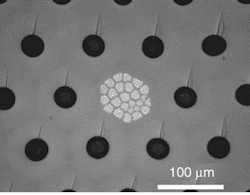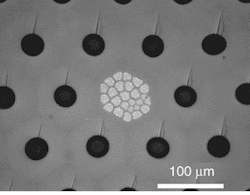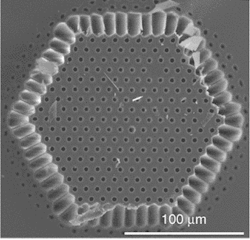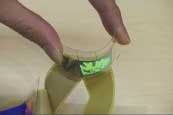Newsbreaks
Scientists set sights on single-photon-counting sensor arrays
Solid-state single-photon-counting avalanche photodiode detectors are useful for fluorescence-decay experiments and other applications. The next step in their evolution would be the development of a low-noise microarray of these devices—a possibility that is, however, thwarted by crosstalk between these devices. Researchers at the University College Cork (Cork, Ireland) and the National University of Ireland (Galway, Ireland) are modeling the crosstalk between detectors in such an array and validating their model with tests on actual devices.
Integrated arrays of this sort are a problem in part because silicon emits light when operated at a diode's breakdown voltage (avalanche operation); the light leads to blooming. Both optical and electrical isolation for pixels will be required (physical separation provides some degree of optical isolation; active quench circuitry also helps). A 1 × 10-pixel array with a 165-µm pitch showed significant crosstalk between adjacent pixels, but not between nonadjacent pixels, indicating that 330 µm is adequate separation. Dark count improves an order of magnitude for every 27°C decrease in temperature; sensors 15 µm and smaller in diameter are suitable for room-temperature operation. Contact Alan Mathewson at [email protected].
Large Ce:LiCAF crystal amplifier produces 98-mJ pulses at 290 nm
The fabrication of a large 1 × 2 × 2-cm Brewster-plate gain module cut from a 5-cm-diameter boule of cerium-doped lithium calcium aluminum fluoride (Ce:LiCAF) has allowed researchers from the Institute for Molecular Research (Okazaki, Japan), Tokin (Saitama, Japan), and Tohoku University (Sendai, Japan) to construct a coaxially pumped tunable ultraviolet power-amplifier module. Pumped with 266-nm light, the device amplifies 290-nm light. The large size of the gain medium permits bow-tie double-pass geometry.
A Ce:LiCAF master oscillator produces 15-mJ 3-ns probe pulses. The double-pass geometry with 3-nm optical delay used in the second amplification pass ensures no significant overlap of the probe pulse at the crystal. Four beams of polarized 8-ns pulses provide the pump power, with total excitation energy at 266 nm of 0.38 J. An extraction efficiency of 25% resulted in 98-mJ 3-ns output pulses at 290 nm. The module performs well enough to be considered for use in a terawatt-class chirped-pulse-amplification laser or as an alternative to frequency-tripled Ti:sapphire lasers for ozone detection, say the researchers. Contact Shingo Ono at [email protected].
Photonic-crystal fiber laser is scalable to high power
Scientists at the University of Bath (Bath, England) are achieving large mode areas and a low effective index step between doped and undoped areas in a ytterbium (Yb)-doped photonic-crystal (PC) fiber laser that is potentially scalable to high power. The doped core region is created by stacking Yb-doped and undoped silica rods, then repeatedly drawing the assembly until the doped regions (425 in all) are very small—250 nm in the final fiber. Surrounding the 15-µm-diameter solid core is a conventional two-dimensional hexagonal air-hole PC structure.
One version of the laser is pumped longitudinally with continuous-wave 915-nm light and emits up to 260 mW at 104 nm at 25% efficiency. Another version, which has a second hexagonal lower-index cladding embedded in the PC cladding structure and an offset core, is multimode and is cladding-pumped by a laser-diode array. With a high-reflectivity mirror at one end of the fiber and a dichroic mirror at the other, the laser emits 3.9 W at 21% slope efficiency. A more carefully fabricated core should boost this efficiency; single-mode high-power versions are possible. Contact William Wadsworth at [email protected].
Uncooled directly modulated distributed-feedback laser is highly linear
In results presented at the Optical Fiber Communication Conference (March 23–28; Atlanta, GA), researchers from Bookham Technology (Abingdon, England) and the University of Cambridge (Cambridge, England) described the development of a directly modulated distributed-feedback laser that combines ultrawide bandwidth with high linearity over a 25°C to 85°C temperature range, and that does not need cooling. The indium phosphide-based, compressively strained, multiple-quantum-well laser incorporates a semi-insulating buried heterostructure for improved thermal performance; the grating is placed in the middle of the laser's active region to improve linearity.
At 25°C, the 1310-nm-emitting laser has a spurious-free dynamic range (SFDR) of 103 dB-Hz2/3 in the 1- to 20-GHz range; the device maintains an SFDR of 90 dB-Hz2/3 in the 1- to 10-GHz range at 85°C. Third-order intermodulation products are below -50 dB (typically -60 dB) at 25°C over a 1- to 20-GHz range. Such devices will be used in the fiberoptic transport of analog microwave and radio frequency signals for in-building-distributed antenna systems in cellular networks, for the growing market in wireless local-area networks, and for radar. Contact Sharon Ostaszewska at [email protected].
Solar-blind ultraviolet photodetectors exploit superlattices
Researchers at Texas Tech University (Lubbock, TX) are exploiting the properties of junctions of short-period lattices in large-bandgap devices to create solar-blind ultraviolet photodetectors based on aluminum gallium indium nitride (AlGaInN) with high AlN content (the higher the AlN content, the shorter the wavelength the device can respond to). The superlattices have a 1.4-nm period, resulting in an effective band gap of 260 nm.
Grown on sapphire without surface passivation, the simple mesa diodes include two superlattice layers (one n- and one p-doped), each with 150 pairs of quantum wells. The average AlN content is 0.63. Near-zero bias, low dark-leakage currents of 0.2 to 0.3 pA were observed; for the 280-µm-diameter device, this corresponds to a leakage current density of 0.3 nA/cm2. The reverse leakage current remains below 50 nA up to a bias of -5 V. The zero-bias resistance is on the order of 1011 Ω. A responsivity of 25 mA/W was measured at 260 nm, decreasing by six orders of magnitude at 380 nm. Contact Sergey Nikishin at [email protected].
Barrier coatings give long life to flexible OLED display
Engineers from Universal Display (UDC; Ewing, NJ), which develops organic-light-emitting-diode (OLED) displays, and Vitex Systems (San Jose, CA), a developer of barrier coatings, have demonstrated a flexible passive-matrix OLED display built on barrier-coated plastic and packaged with a thin-film multilayered barrier. Small flexible displays, which are desirable for use in portable electronic devices, do not work well when based on conventional liquid-crystal technology, which cannot survive finger contact if made on flexible substrates.
The display consists of a 0.18-mm-thick clear plastic faceplate, a multilayer barrier, the OLED layer, and another multilayer barrier. The OLED layer itself is less than 0.5 µm thick and the multilayer barriers are 1 to 2 µm thick. As explained by Julie Brown, UDC's vice president and chief technology officer, the barriers contain alternating layers of polymer and inorganic material (aluminum oxide); the purpose of the multilayer structure is to decouple any pinholes in the individual layers to maintain the integrity of the seal. The 64 × 64-pixel, 32-level gray-scale display has 80-dpi resolution and can be flexed to a radius of curvature of less than an inch. Contact Julie Brown at [email protected].



